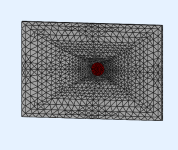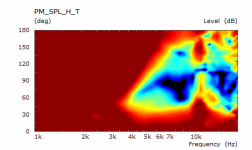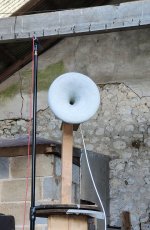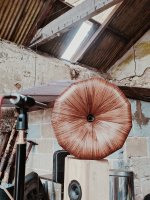Newbie question
I read about both conical and exponential horns... As I understand it conical present better (even) load across the spectrum but of course has to be bigger for reaching deeper.
what about a hybrid of the two concept, cones and pros?

I read about both conical and exponential horns... As I understand it conical present better (even) load across the spectrum but of course has to be bigger for reaching deeper.
what about a hybrid of the two concept, cones and pros?
What you show are basically two different OSSE waveguides, there's nothing exponential about it -


The left one in your picture has a conical extension (cylindrical in this case), that has been the main subject of the last several pages of this thread... 🙂
It can work very well, as has been shown, but at the moment it's not clear exactly how it's possible and what are the requirements.
The left one in your picture has a conical extension (cylindrical in this case), that has been the main subject of the last several pages of this thread... 🙂
It can work very well, as has been shown, but at the moment it's not clear exactly how it's possible and what are the requirements.
Yes, I`m reading it through and trying to keep up, excellent thread!The left one in your picture has a conical extension (cylindrical in this case), that has been the main subject of the last several pages of this thread... 🙂
It can work very well, as has been shown, but at the moment it's not clear how/why.
Here is a second sketch to illustrate what I mean.
Left pic, seg1-cylinder...seg2- OS-SE
Right pic. seg1-conical...seg2 OS-SE
Regarding directivity (polars, diffractions, etc.), you can model/simulate both with Ath+ABEC/AKABAK right away, that's easy and it should answer all you questions. As for the "loading" aspect, that's what still leaves some questions open...
It's so complex topic that there are really no short answers. It seems that the actual drivers can play an important role and they should be included in the model with all their complexities (which is not readily available, unfortunately).
It's so complex topic that there are really no short answers. It seems that the actual drivers can play an important role and they should be included in the model with all their complexities (which is not readily available, unfortunately).
Last edited:
I started with the 2-profile geometry, but the result does seem weird.. Can someone give me tip what I am doing wrong here? The only idea I have is that ,somehow, only the horn adapter is seen as solid.




; __ Parameters __
HornGeometry = 2
Length = 40
Throat.Diameter = 25.4
Throat.Angle = 10.08
Horn.Adapter = {
L = 5
k = 0.01
Width = 44
Height = 30.46
;SC = 0
Segments = 6
;ZCtrl = 0.5,0.3,0.5,0.3
}
Horn.Part:1 = {
L = 35
Segments = 10
H = {
r0 = 12.7
a0 = 65
k = 2
s = 1.27
a = 65
n = 2.15
q = 0.995
}
V = {
r0 = 12.7
a0 = 45
k = 2
a = 45
s = 1.27
n = 2.15
q = 0.995
}
;ZMap = 0.5,0.3,0.5,0.9
}
; __ Source Mode __
Source.Shape = 1
Source.Curv = 0
Source.Radius = -1
Source.Velocity = 1
; __ Enclosure __
;Mesh.Enclosure = {
;Spacing = 70,70,70,367 ; edge distances (left,top,right,bottom)
;Depth = 200
;EdgeRadius = 60
;EdgeType = 1
;FrontResolution = 15,15,25,25
:BackResolution = 25,25,30,30
;LFSource.B = {
; Spacing = 70
; Radius = 106.5
; DrivingWeight = 1.0
; SID = 1
; }
;}
; __ LE Model __
LE = generic25
; __ 3D Mesh Settings __
Mesh.LengthSegments = 28
Mesh.AngularSegments = 72
Mesh.ThroatResolution = 4
Mesh.MouthResolution = 14
Mesh.SubdomainSlices =
;Mesh.InterfaceOffset = 5
Mesh.ZMapPoints = 0.5,0.1,0.76,0.733
;Mesh.Quadrants = 14
; __ Measurement Axis __
;Mesh.VerticalOffset = 91.436
; __ ABEC Settings __
ABEC.MeshFrequency = 1000
ABEC.NumFrequencies = 50
ABEC.SimType = 2
ABEC.f1 = 1000
ABEC.f2 = 20000
; __ VCAS Output __
ABEC.Polars:SPL = {
MapAngleRange = 0,180,72
Distance = 2.0
}
;ABEC.SphericalField:1 = {
;Radius = 0.8
; Angle = 180
; Density = 30
;}
ABEC.Polars:SPL_H_T = {
;SID = 0
MapAngleRange = -180,180,72
Distance = 2
NormAngle = 0
;FRDExport = {
;NamePrefix = hor_tweeter
;PhaseComp = -2
}
}
ABEC.Polars:SPL_V_T = {
;SID = 0
MapAngleRange = -180,180,72
Distance = 2
Inclination = 270
NormAngle = 0
;FRDExport = {
;NamePrefix = ver_tweeter
;PhaseComp = -2
}
}
; __ Ath Report __
Report = {
Title = "65DG"
Width = 1200
Height = 800
NormAngle = 0
}
; __ File Output __
Output.ABECProject = 1
Output.STL = 1
Output.MSH = 1
It works fine on my installation. Maybe try to change the NUC setting and restart ABEC.
(You have some syntax errors due to unmatched "}". A better way to quickly deactivate whole items is to type (e.g.) an underscore in front of it, like "_FRDExport".)
(You have some syntax errors due to unmatched "}". A better way to quickly deactivate whole items is to type (e.g.) an underscore in front of it, like "_FRDExport".)
Is there a practical approach how to make the transition between the horn adapter and the profiles seamless / continuous?
I read about both conical and exponential horns... As I understand it conical present better (even) load across the spectrum but of course has to be bigger for reaching deeper.
Exponential horns are best regarding acoustical input impedance at the throat. This concerning also the length of the horn - their dimensions are smaller for the same low frequency cut-off. Normalized acoustical impedance, A + jB, looks like this:
(fo is the horn critical frequency, the horn does not transmit power below fo, this applies to infinite horn. For a finite length, there is always some transfer below fo)
So what are the trades off of using a conical horn? apart from size...
Here is the founder of Oma talking fondly of conical horns...
Here is the founder of Oma talking fondly of conical horns...
Last edited:
Conical horns are one of the worst types of horns.
A great deal of the reason that the ATH horns work so nicely is that there's a smooth transition from the diaphragm of the tweeter to the horn, and a smooth transition from the mouth of the horn to the room. Check out the pics of the "cutting edge" aka "CE" waveguides for an example.
Conical horns feature neither, and should be avoided IMHO. I think people build conical horns because they're easy to build and that's about it.
EDIT:
Note that some of the ATH waveguides, as well as the oblate spheroidal waveguides look similar to conical. Devil is in the details, the throat and the mouth geometry in particular.
You can evaluate this yourself with ATH and ABEC of course, and tweaking the models is a great way to learn what works and what doesn't.
A great deal of the reason that the ATH horns work so nicely is that there's a smooth transition from the diaphragm of the tweeter to the horn, and a smooth transition from the mouth of the horn to the room. Check out the pics of the "cutting edge" aka "CE" waveguides for an example.
Conical horns feature neither, and should be avoided IMHO. I think people build conical horns because they're easy to build and that's about it.
EDIT:
Note that some of the ATH waveguides, as well as the oblate spheroidal waveguides look similar to conical. Devil is in the details, the throat and the mouth geometry in particular.
You can evaluate this yourself with ATH and ABEC of course, and tweaking the models is a great way to learn what works and what doesn't.
Neither exponential nor straight conical horns are suitable for high quality sound reproduction. The former because of its strong beaming and the latter because of the abrupt termination, limiting the use to a narrow band.
Last edited:
the hair ... 🤣Here is the founder of ...
It's surprisingly beamy. Are you sure you kept the profile? 🙂
(For this particular driver it may not be the worst thing, as it obviously doesn't go very high by itself...)
(For this particular driver it may not be the worst thing, as it obviously doesn't go very high by itself...)
I checked and it could be, the circular versions generally beam a little more than the hexagonal. (I take the profile at the center of a petal as the reference for these comparisons.)
BTW, Faital HF1000 has a cylindrical (0°) exit section. Normally, I would probably avoid such driver, but it could be interesting to try to insert different lengths of a straight tube between the driver and a horn...
- Home
- Loudspeakers
- Multi-Way
- Acoustic Horn Design – The Easy Way (Ath4)

